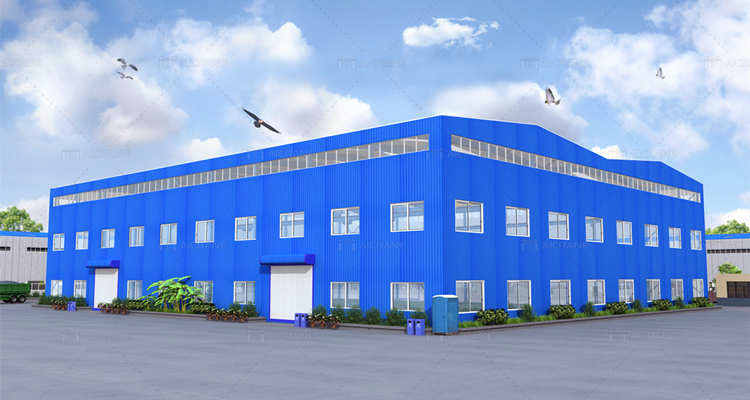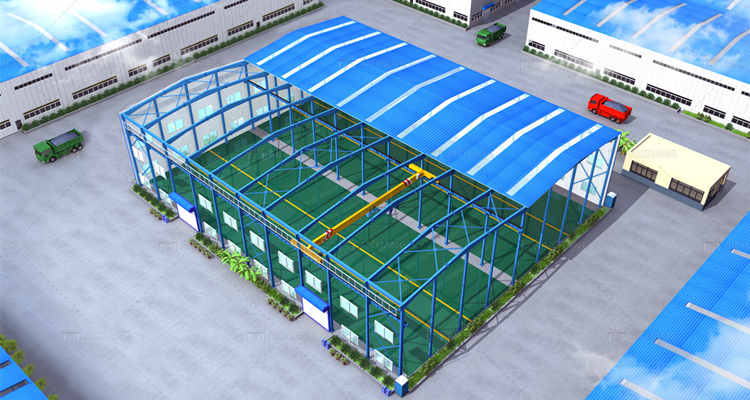A factory steel structure offers numerous advantages, such as strength, durability, and cost-effectiveness, making it a popular choice for industrial buildings. However, in a humid environment, steel structures face challenges like corrosion, condensation, and structural degradation over time. Proper planning, maintenance, and protective measures can ensure the longevity and stability of the steel structure in such conditions. Below are practical tips to address these challenges and maintain the integrity of your factory steel structure in a humid environment.

Choose Corrosion-Resistant Materials
Corrosion is one of the most significant threats to steel structures in humid environments. To mitigate this issue:
Use high-quality, corrosion-resistant steel, such as weathering steel, which forms a protective oxide layer to resist rust.
Apply protective coatings like galvanization or epoxy paint to shield the steel from moisture.
Consider stainless steel for critical areas exposed to constant humidity or water contact.
Investing in corrosion-resistant materials during the construction phase reduces maintenance costs and prolongs the lifespan of the structure.
Implement Proper Ventilation Systems
Humidity levels can be controlled effectively with a well-designed ventilation system. Proper airflow reduces moisture buildup, preventing issues like condensation and mold growth. Tips for ventilation include:
Install roof vents, wall louvers, and exhaust fans to facilitate air circulation.
Use dehumidifiers in enclosed or high-humidity areas to maintain optimal moisture levels.
Ensure adequate spacing between equipment and walls to allow free airflow.
A robust ventilation system not only protects the steel structure but also enhances the working environment for employees.
Apply Moisture-Resistant Paints and Coatings
Protective coatings are crucial for shielding a factory steel structure from moisture-related damage. Regularly inspect and reapply coatings to maintain their effectiveness. Types of coatings to consider include:
Epoxy or polyurethane paints for exterior surfaces exposed to weather.
Bituminous coatings for areas in contact with the ground or water.
Anti-condensation coatings for interior surfaces prone to moisture buildup.
Properly applied coatings act as a barrier, minimizing direct exposure to humidity.
Incorporate Insulation Solutions
Insulation plays a vital role in controlling temperature and reducing condensation in a humid environment. Insulation materials can prevent steel surfaces from coming into contact with moist air, thus reducing the risk of corrosion. Effective insulation strategies include:
Use spray foam insulation or fiberglass batts to create a barrier against moisture.
Install vapor barriers on walls and roofs to block humidity.
Ensure that insulation materials are non-absorbent and resistant to mold growth.
These measures help maintain the structural integrity of the factory steel structure while improving energy efficiency.

Ensure Proper Drainage Systems
Effective drainage systems prevent water accumulation, a common issue in humid environments. Standing water can lead to structural damage and corrosion over time. To ensure proper drainage:
Design sloped roofs to direct rainwater away from the structure.
Install gutters and downspouts to channel water away from the foundation.
Use waterproof membranes on floors and foundations to prevent water seepage.
Regular maintenance of drainage systems is essential to prevent blockages and ensure their efficiency.
Perform Regular Inspections and Maintenance
Regular inspections are crucial for identifying and addressing potential issues before they escalate. Create a maintenance schedule that includes:
Checking for rust, peeling paint, or other signs of corrosion.
Inspecting joints, bolts, and welds for structural integrity.
Cleaning surfaces to remove dirt, moisture, and debris that can accelerate corrosion.
Reapplying protective coatings or sealants as needed.
Proactive maintenance ensures the factory steel structure remains safe and functional in a humid environment.
Consider Climate-Specific Design Features
Designing the factory steel structure with the local climate in mind can enhance its resilience. Features to consider include:
Elevated foundations to prevent water damage in flood-prone areas.
Overhangs or canopies to protect walls from direct exposure to rain.
Sloped surfaces for efficient water runoff.
Incorporating these design elements minimizes the impact of humidity and moisture on the structure.
Use Dehumidification Systems
In regions with consistently high humidity, dehumidification systems can be essential. These systems help maintain a stable indoor environment by reducing moisture levels. Key considerations include:
Installing industrial-grade dehumidifiers for large spaces.
Using humidity sensors to monitor and adjust moisture levels in real time.
Combining dehumidification systems with air conditioning to optimize performance.
By actively managing humidity, dehumidification systems protect both the steel structure workshop and the equipment housed within it.
Select Appropriate Flooring Solutions
The foundation and flooring of a factory steel structure are also vulnerable to humidity. To prevent issues like water seepage and structural weakening:
Use concrete slabs with waterproofing additives to resist moisture penetration.
Apply epoxy or polyurethane floor coatings to create a moisture barrier.
Install drainage channels or sump pumps in areas prone to water accumulation.
Durable, moisture-resistant flooring contributes to the overall stability of the structure.
Train Staff on Maintenance Practices
Employees play a critical role in maintaining the factory steel structure. Conduct regular training sessions to ensure staff are aware of best practices, such as:
Reporting signs of corrosion or damage promptly.
Cleaning equipment and surfaces to prevent moisture buildup.
Understanding the importance of maintaining drainage systems and ventilation.
A well-trained workforce can identify and address potential issues, reducing the risk of long-term damage.
Collaborate with Experts and Suppliers
Working with experienced contractors and suppliers ensures that the factory steel structure is designed and maintained to withstand humid conditions. Choose suppliers like Aicrane who:
Offer high-quality steel materials and protective coatings.
Provide expert guidance on design and maintenance.
Offer warranties and after-sales support for their products.
Collaboration with experts minimizes risks and ensures the structure remains durable in challenging environments.
Maintaining a factory steel structure in a humid environment requires proactive planning, appropriate materials, and regular maintenance. By implementing measures such as corrosion-resistant coatings, effective ventilation, and proper drainage systems, you can safeguard the structure against humidity-related challenges. Combining these strategies with routine inspections and staff training will ensure the longevity and stability of the steel structure, even in the most humid conditions.